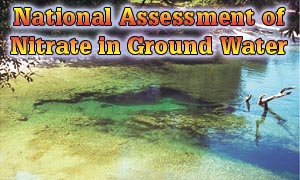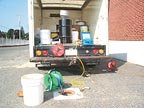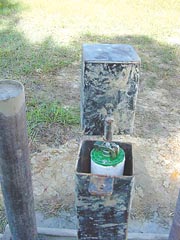
Sampling water from wells is undoubtedly the most direct and reliable method for collecting information about the quality of ground water. To successfully manage our nation's ground water resources, however, we cannot rely on monitoring alone. Such an assessment requires more information than can be measured directly in all places and at all times. Predictive tools such as models are needed to extrapolate measured conditions and contamination risk to unmonitored, comparable areas.
By integrating data from both monitoring and models, the U.S. Geological Survey (USGS) has assessed ground water quality over broad areas - covering states, regions and the nation. For example, the USGS National Water Quality Assessment (NAWQA) program has assessed the risk of nitrate contamination in shallow ground water across the conterminous United States on the basis of:
- nitrate concentrations measured by the NAWQA Program from 1992 to 1999 at nearly 2,000 wells
- national data sets on sources of nitrogen
- factors known to affect the susceptibility of ground water to contamination.
This assessment provides estimates of the likelihood of nitrate occurring at or above certain thresholds, as well as an improved understanding of the factors affecting the occurrence and movement of chemicals in ground water. The assessment establishes linkages between nitrate contamination and spatial information on land use, sources of chemicals, geology, hydrology, soils and other watershed features - thus providing an understanding of why some areas are at higher risk for contamination.

Why Nitrate?
Nutrients are applied to the land surface for a variety of agricultural, residential and other purposes. Unfortunately, elevated concentrations of nitrate - a common form of nitrogen - can cause negative ecological and human-health effects. Too much nitrate in surface water, for example, can contribute to algal blooms and fish kills in coastal waters. Ground water discharge carrying nitrate can be a major contributor to such elevated concentrations in surface water.Elevated concentrations of nitrate in drinking water also are associated with adverse health effects in infants. Specifically, children younger than six months fed with formula made from water containing nitrate may develop “blue baby” syndrome (methemoglobinemia). For this reason, the U.S. Environmental Protection Agency (EPA) established a drinking-water standard for nitrate of 10 milligrams per liter. In addition, recent findings from certain parts of the country indicate that long-term exposure to elevated concentrations of nitrate may be a human-health risk, contributing to the risk of developing bladder and ovarian cancers and non-Hodgkin's lymphoma.
Because nitrate is both soluble and mobile, the chemical commonly is found in ground water. In fact, nitrate is one of the most widespread contaminants in shallow ground water. Water from shallow monitoring wells (average depth about 60 ft. below land surface) exceeded the EPA drinking water standard in 20 percent of NAWQA samples in agricultural areas, and in 3 percent of samples in urban areas.
More than 7 percent of NAWQA samples from domestic drinking water wells (average depth 180 ft. below land surface) exceeded the standard. This may require special consideration, as more than 40 million people in the United States consume ground water from domestic wells. Homeowners usually are not aware of potential risks because domestic wells are not monitored regularly, as is required by the Safe Drinking Water Act for large public-supply wells. For example, many homeowners in recently established residential areas that rely on domestic wells for drinking water are not aware that their wells may be affected by chemicals leached from land that previously was farmed. Such chemicals can remain in shallow ground water for decades.
Water in deeper, confined aquifers is more protected beneath the land surface, and nitrate contamination is minimal. Only 3 percent of public-supply wells (average depth 550 ft. below land surface) sampled by NAWQA exceeded the EPA drinking water standard. However, all ground water is part of an integrated system and is not fully protected from future contamination as shallow ground water moves downward. Future contamination in the deeper aquifers used for drinking water could pose serious concerns because cleanup of this relatively inaccessible and slow-moving water is costly and difficult.
High Risk, Low Risk
The USGS model demonstrates that nitrate concentrations are expected to be lowest in shallow ground water underlying areas with low inputs of nitrogen and poorly drained soils, and highest in areas with high nitrogen inputs and well drained soils that overlie unconsolidated sand and gravel aquifers.Some areas of highest risk are in northeastern Nebraska, the upper Midwest, northwestern Texas and parts of the Mid-Atlantic and western states. For example, the risk is high in shallow ground water underlying eastern Washington because of heavy irrigation and high rates of fertilizer application.
Some areas of lowest risk are in parts of the southeastern Coastal Plain. Denitrification resulting from large amounts of organic carbon in water-logged soils contribute to the low nitrate concentrations in shallow ground water.
Low concentrations of nitrate also are predicted in parts of southern Indiana, despite relatively high fertilizer applications. Soils in this area - largely composed of glacial till - are fine-textured and poorly drained, which slows the movement of water and nitrate to the water table. Ditches and tile drains in the poorly drained fields also divert excess water and nitrate to nearby streams.
In all cases cited above, measured concentrations of nitrate generally support model predictions of risk in shallow ground water. For example, nitrate in shallow ground water underlying irrigated corn fields in Nebraska - predicted as an area of highest risk - has a median concentration of about 25 milligrams per liter (from data collected by both USGS and the state of Nebraska).
Exceptions can occur where processes are locally controlled and highly variable. For example, in New Mexico's Rio Grande Valley, nitrogen inputs and the predicted risks are high, but measured concentrations generally are low. Over-prediction by the model can be explained, in part, because evapotranspiration, which is high in the southern part of the valley and is not included in the model, can minimize the amount of water and nitrate moving downward to the water table.

Using the Findings
These findings have important implications for ground water management. Predictions of risk and an improved understanding of ground water conditions on a national basis can help states, regional and federal agencies, and other stakeholders to:
- Protect ground water that is at highest risk, and target monitoring to those aquifers that are most vulnerable. Resources can be directed to areas most likely to benefit from source-water protection and pollution-prevention programs (as mandated under the Federal Amendments to the Safe Drinking Water Act, 1996).
- Target key sources of nitrate - such as fertilizer applications - in the implementation of best management strategies. An improved understanding of relations between nitrogen sources and factors controlling the movement of nitrate in ground water helps with evaluating the effectiveness of those strategies. Controlling factors include rates and paths of ground-water flow, as well as characteristics of the land in which ground water originates. In some settings, it may take decades before ground water quality improves as a result of reductions in inputs of nitrate on land. Long-term monitoring strategies are needed to effectively monitor such progress.
- Provide preliminary assessments of other contaminants, such as atrazine and other pesticides, which commonly co-occur with nitrate in shallow ground water. Pesticides generally are more costly and difficult to measure; using nitrate as a surrogate can result in cost-effective and improved monitoring programs.
Future Role of Models
The USGS nitrate model demonstrates the key role that models can play in the assessment of ground water quality over broad regions, states and the nation. They provide a cost-effective approach - particularly when the expense of monitoring limits the number of wells that can be monitored - for prioritizing source-water protection, targeting and evaluating management strategies, and designing more efficient and integrated monitoring programs over the long term.
Models only are successful, however, if they are developed and verified with “on-the-ground” measurements. With demonstrated reliability based on comparisons to measured conditions, model results can be viewed with confidence, which enhances their usefulness in water-resource assessment, management and decision-making.
ND

Report Abusive Comment